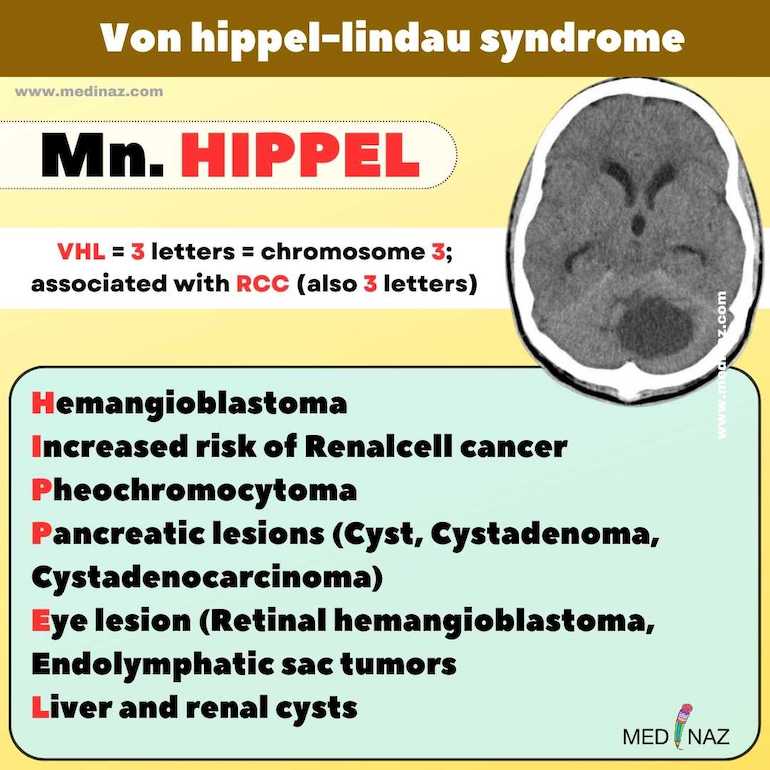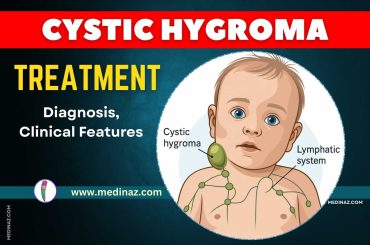Von Hippel-Lindau Syndrome USMLE Notes & Mnemonics contains all the high-yield points you need to know.
Definition:
- Von Hippel-Lindau (VHL) Syndrome: A hereditary cancer syndrome leading to a variety of benign and malignant tumors. (Ref)
Genetics:
- Autosomal Dominant inheritance.
- Mutation in VHL gene on chromosome 3p25-26, tumor suppressor gene.
Pathophysiology:
- Loss of VHL Function: Leads to increased hypoxia-inducible factor (HIF) and upregulation of angiogenic and growth factors like VEGF.
Clinical Features:
- Hemangioblastomas: In the brain (especially cerebellum) and spinal cord.
- Renal Cell Carcinoma (RCC): Clear cell type, often bilateral and multifocal.
- Pheochromocytomas: Benign adrenal gland tumors that can cause hypertension.
- Pancreatic Cysts and Neuroendocrine Tumors.
- Retinal Angiomas: Can lead to vision loss.
- Endolymphatic Sac Tumors: Can cause hearing loss.
Diagnosis:
- Genetic Testing: For VHL mutations.
- Imaging: MRI for brain and spinal cord lesions, abdominal CT for renal and adrenal tumors.
- Ophthalmologic Examination: For retinal angiomas.
- Plasma and Urinary Metanephrines: If pheochromocytoma is suspected.
Management:
- Surveillance: Regular screening for tumors (brain, spinal cord, kidneys, adrenal glands, pancreas).
- Surgical Resection: For symptomatic hemangioblastomas and RCC.
- Management of Pheochromocytoma: Surgical removal, blood pressure control.
- Laser Therapy: For retinal angiomas.
Von Hippel-Lindau Syndrome USMLE Mnemonic: “HIPPEL”
- Hemangioblastomas
- Increased risk of RCC
- Pheochromocytomas
- Pancreatic cysts and tumors
- Endolymphatic sac tumors
- Loss of VHL gene function

Chart: VHL Syndrome Features and Management
| Feature | Clinical Significance | Management Strategy |
|---|---|---|
| Hemangioblastomas | Brain/spinal cord lesions; may be symptomatic | Surveillance; Surgery if needed |
| Renal Cell Carcinoma | High risk; often bilateral/multifocal | Regular abdominal CT; Surgery |
| Pheochromocytomas | Hypertension; episodic symptoms | Blood pressure control; Surgery |
| Pancreatic Neuroendocrine Tumors | Can be symptomatic or asymptomatic | Surveillance; Surgery if needed |
| Retinal Angiomas | Vision loss risk | Ophthalmologic exams; Laser therapy |
| Endolymphatic Sac Tumors | Hearing loss | Surveillance; Treatment as needed |
Note: For the USMLE, it’s important to recognize the constellation of tumors associated with VHL syndrome and the necessity of lifelong surveillance and management. Questions may focus on genetics, clinical presentation, or associated risks for various neoplasms. Understanding the autosomal dominant inheritance pattern and the role of the VHL gene in tumor suppression is also crucial.
Check other important USMLE Notes
A Visual Learning Platform





